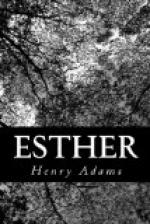His thirteenth-century ideas led him into a curious experiment which was quite in the thirteenth-century spirit. Catherine’s insatiable spirit of coquetry was to blame, although it was not with him that she coquetted. Ready enough to try her youthful powers on most men, she had seemed to recognize by instinct that Mr. Hazard did not belong to her. Yet she could not rest satisfied without putting even him to some useful purpose of her own.
During Hazard’s visits to the scaffold, he sometimes took up a pencil and drew. Once he drew a sketch of Wharton in the character of a monk with his brush and pallet in his hands. Catherine asked what connection there was between Mr. Wharton and a monastery.
“None!” replied Mr. Hazard; “but I like to think of church work as done by churchmen. In the old days he would have been a monk and would have painted himself among these figures on the walls.”
Esther ventured to criticise Wharton’s style; she thought it severe, monotonous, and sometimes strained.
“Wharton’s real notion of art,” said Hazard, “is a volcano. You may be a volcano at rest, or extinct, or in full eruption, but a volcano of some kind you have got to be. In one of his violent moods he once made me go over to Sicily with him, and dragged me to the top of Etna. It fascinated him, and I thought he meant to jump into it and pull me after him, but at that time he was a sort of used-up volcano himself.”
“Then there is really something mysterious about his life?” asked Catherine.
“Only that he made a very unhappy marriage which he dislikes to think about,” replied Hazard. “As an artist it did him good, but it ruined his peace and comfort, if he ever had any. He would never have made the mistake, if he had not been more ignorant of the world than any mortal that ever drew breath, but, as I was saying, a volcano was like a rattlesnake to him, and the woman he married was a volcano.”
“What has become of her?” asked Esther.
“I have not dared to ask for years. No one seems to know whether she is living or dead.”
“Did he leave her?”
“No; she left him. He was to the last fascinated by her, so much so that, after she left him, when I persuaded him to quit Paris, he insisted on going to Avignon and Vaucluse, because Petrarch had been under the same sort of fascination, and Wharton thought himself the only man in the world who could understand Petrarch. If you want to insult him and make him bitterly hate you, tell him that Laura was a married woman with a dozen children.”
“Who was Laura?” asked Catherine; “and why should she not have a dozen children?”
“Laura was a beautiful girl with golden hair and a green dress whom Petrarch first saw in a church at Avignon,” answered Hazard. “She was painted among the frescoes of the cathedral, as you are being painted now, Miss Brooke; and Petrarch wrote some hundreds of sonnets about her which Wharton undertook to translate, and made me help him. We were both poets then.”




